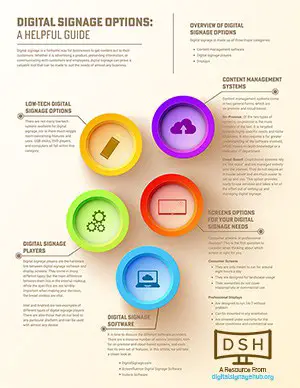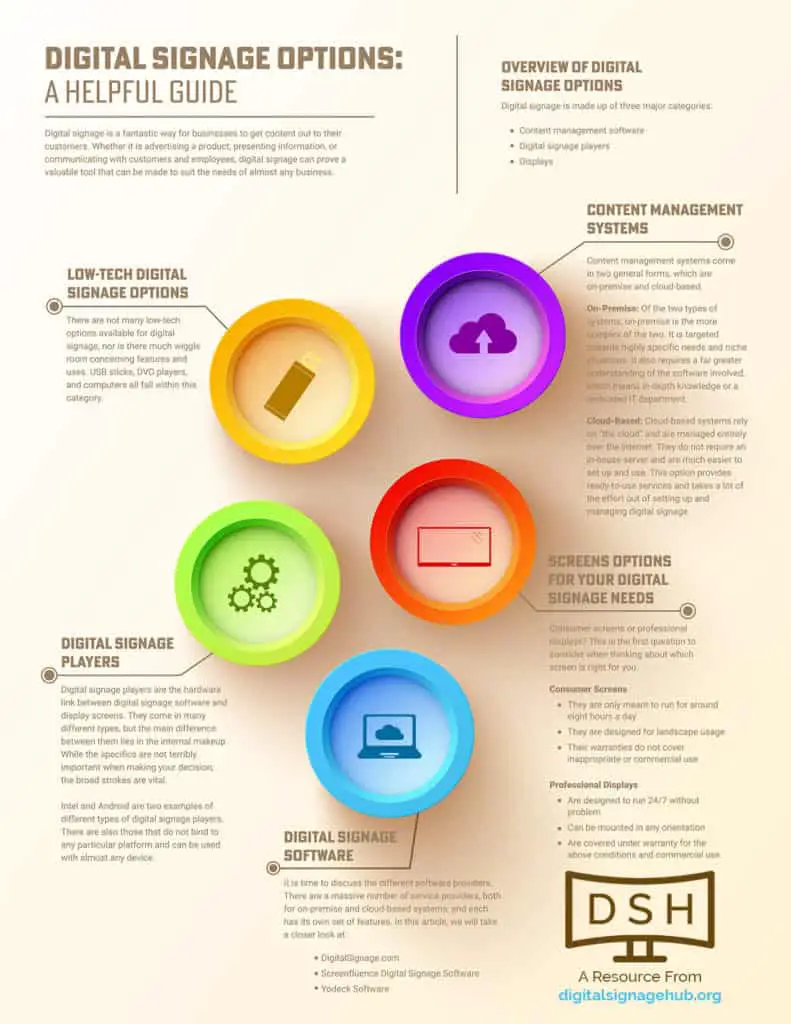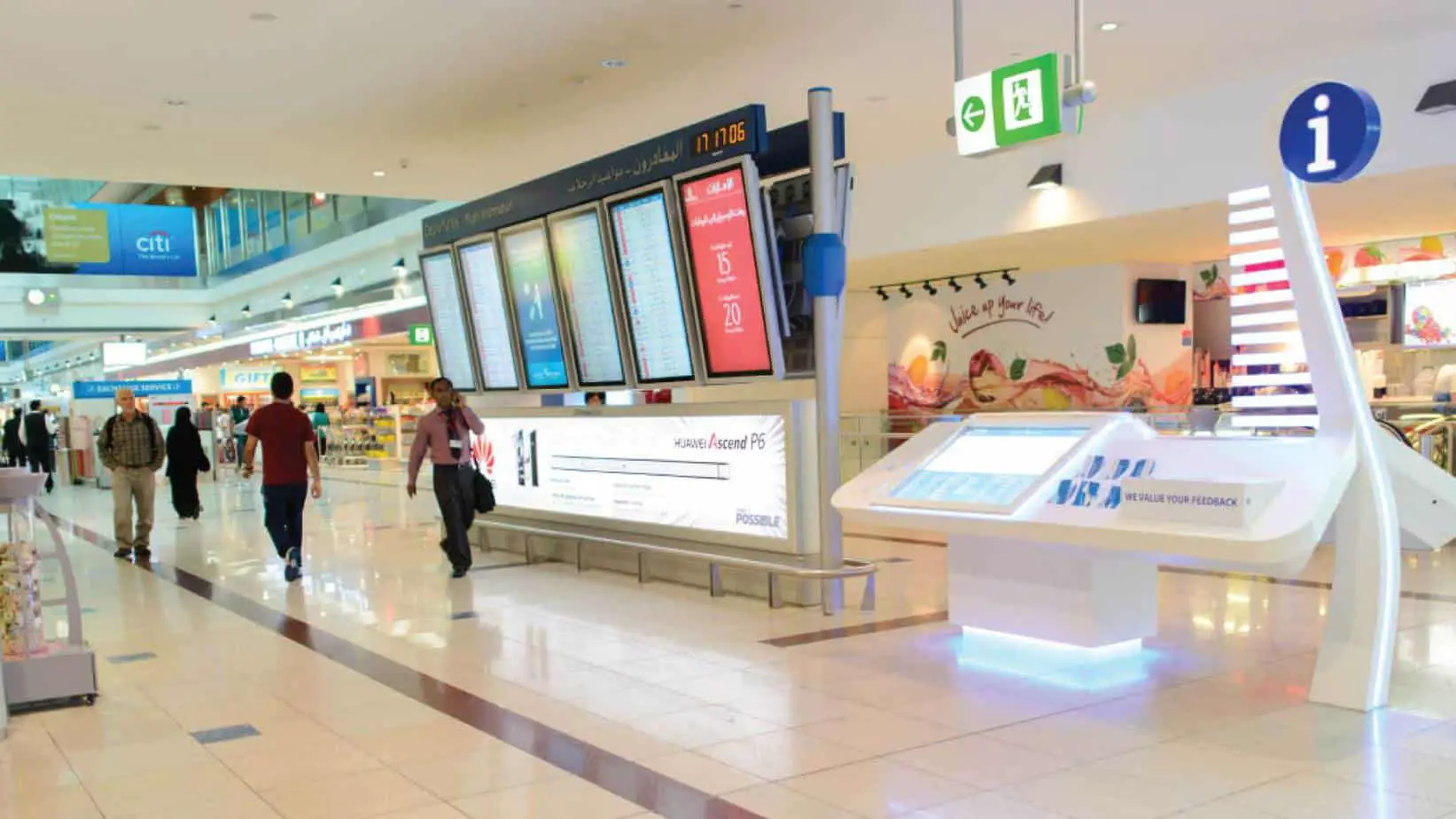This post contains affiliate links.

Digital signage is a fantastic way for businesses to get content out to their customers. Whether it is advertising a product, presenting information, or communicating with customers and employees, digital signage can prove a valuable tool that can be made to suit the needs of almost any business.
The different options for digital signage include various content management options, display screens, and digital signage players. The combination of these features makes up digital signage and determines the features available.
The number of options for digital signage can be overwhelming, but that does not have to be the case. In this article, you will learn how easy it can be once you know what your options are.
Overview of Digital Signage Options
Getting started with digital signage can seem complex and overwhelming at first glance. However, while figuring out where to start amidst the multitude of options may seem daunting, it becomes much simpler once you know the basics.
Digital signage is made up of three major categories:
- Content management software
- Digital signage players
- Displays
Nothing is more important in digital signage than content management software. While the software comes in many different forms, it is the brain of the operation, determining how content is managed and presented. Digital signage players and displays are also important and varied, but they are dependent on the software.
There are a few exceptions to the above categories, however. For certain low-tech solutions like USB sticks, the only option is to plug in and play, with no ability to adjust or manage the content further.
Digital Signage Needs
While we will be discussing these various options in detail, it will boil down to what suits you. Each business has its own individual needs, ranging from things like getting the most out of limited space to being able to adjust content regularly and in creative ways. The first step to choosing the right digital signage for you is understanding these needs.
If you are here, you may already have an idea about what you are looking for. However, even if you do not, you can still get an idea of where to start by considering a few important factors:
- The type and flexibility of content you wish to present
- The size, number, and features of the displays
- Your budget, both upfront and in the long run
- Any special requirements you may have that require specific features
Once you are clear on what you need, it becomes much easier to figure out where to start. Focusing on answering these questions will allow you to purchase a system that meets your needs and can support future needs as well.
Content
The type of content you wish to display is the perfect place to start when thinking about digital signage. Do you simply want a static display or a looping set of images? If so, you can go low-tech. However, if you have more specific needs or want to display your content in more complex and dynamic ways, you will have to consider other options.
Questions to consider when thinking about content:
- What do you want to display?
- How often will you want to change the content you display?
- Do you have any niche needs?
What you want to display is the simplest question. Do you want a single picture with a few lines of text? Do you want a video? What about interactive displays? Actually, it is much simpler than that. If you want to do more than show videos or images on a loop, then you will need content management software.
The same can be said for the other two questions. If you want to change the content regularly or have any niche needs, then the low-tech options are not suited for you. More likely than not, you will want to explore digital signage solutions that include content management software.
Displays

Pushing content is the purpose of digital signage, but displays are equally vital. Consider how many displays you need. If the answer is one or two, you can get away with a low-tech option. However, if you need many displays, you will want to look towards more complex solutions involving content management software.
It is not just the number of displays that is important. Content management software is incredibly useful for utilizing displays in different locations. If you go with a low-tech option, a lot of manual updating is required, which involves physically traveling to the display. Content management software allows updating from anywhere and at any time.
Lastly, consider what you need out of a display. Low-tech options can utilize TVs and computer screens, but those devices are only meant for short-term use, and they can only be placed in certain orientations. On the other hand, professional digital signage displays are suited for long-term use and come with many useful features.
Budget
Budget is a major factor when considering any form of advertisement, but it does not take much to venture into the world of digital signage. In fact, for a low-tech setup, you can plan on spending under 200 dollars. It is not just low-tech that is affordable, either.
Complete content management systems can be expensive, but there are low-cost options. Particularly, cloud-based content management systems have low upfront costs and affordable monthly payments. Some even come with digital signage players included or can be used on a single display for free.
Keep these things in mind when estimating the costs for you:
- Most cloud-based services charge monthly per screen
- Professional displays cost more but last longer than consumer TVs and monitors
- Some services allow you to manage one screen at no cost, and most provide demos
- The price is greatly influenced by the available features
So what do you need?
With the availability of demos and free use for single screens, content management software has a clear edge. If you do not have internet access or wish to use equipment that you already have on hand, then you can still consider low-tech options. Otherwise, content management systems utilizing specialized software are better.
However, even if content management systems are the obvious choice, there are many different displays, digital signage players, and software providers to consider.
Low-Tech Digital Signage Options
There are not many low-tech options available for digital signage, nor is there much wiggle room concerning features and uses. USB sticks, DVD players, and computers all fall within this category.

Using a USB stick is a simple solution to create basic displays. Load PowerPoint with some images, adjust the settings as you like, then convert it all into a video. After that, you simply plug it into a TV and play the video on loop, without being able to do much else. It is the same for a DVD player or any similar device.
A computer offers a few more options. You can directly use PowerPoint or similar programs from the computer and have them displayed on a screen without the need to convert it to videos. This gives a few more options as far as customizing the content displayed on the screen, but it does little else.
All of the above options have similar problems. However, despite the limited content and management options, they can be useful tools in the right situation. This is especially true for applications that are not permanent or will only be used for short durations.
Low-Tech Equipment
- A TV or Computer Screen: An Insignia 32-inch Smart HD TV will cost around 120 dollars, while an HP 23.8-Inch computer monitor will cost around 140 dollars. Computer monitors generally offer a higher resolution, but either will do.
- USB Stick or DVD Player: The PNY 32GB Turbo Attaché 3 USB 3.0 Flash Drive runs about 10 dollars, while a Sony DVD player can be purchased for around 40 dollars. Many TVs even come with built-in DVD players.
- A Computer: The HP Chromebook 14-inch FHD Laptop is around 300 dollars. Keep in mind that without the proper setup, the computer must remain connected to the display.
- Misc: Wall mounts and various cables may also be necessary when setting up these digital signage options. Always consider how much space you have to work with.
Content Management Systems
For most, using a content management system is advised. A content management system is as straightforward as it sounds. It is a system meant to manage every aspect of content, including:
- Storing and delivering content
- Adapting content to suit the display
- Managing playlists
- Arranging and combining content into various layouts
Those are only a few of the many features of content management systems. Many even allow you to monitor your digital signage displays from afar, knowing if there are any problems without having to physically see them. This is a major benefit that the low-tech options do not have.
If you are convinced about the benefits of content management systems, the next step is to decide which of the two types of content management systems are for you.
The Two Types of Content Management Systems
Content management systems come in two general forms, which are on-premise and cloud-based.
- On-Premise: Of the two types of systems, on-premise is the more complex of the two. It is targeted towards highly specific needs and niche situations. It also requires a far greater understanding of the software involved, which means in-depth knowledge or a dedicated IT department.
- Cloud-Based: Cloud-based systems rely on “the cloud” and are managed entirely over the internet. They do not require an in-house server and are much easier to set up and use. This option provides ready-to-use services and takes a lot of the effort out of setting up and managing digital signage.
For most needs, a cloud-based system is recommended. However, that is not always the case, so we will go through both systems to make sure you chose the option that is right for you.
On-Premise Content Management Systems
Both types of content management systems have their own advantages, but on-premise systems tend to lean towards niche markets. For instance, those who have or want a local server and wish to upload and manage their content management software personally. This likely means having IT knowledge or an IT department.
Those looking for ownership and immense customization may also choose an on-premise solution. This is because you purchase licenses when dealing with on-premise content management software. It also means unlimited ability to customize to perfectly fit your needs at any given time.
Security is another concern that can be remedied with the use of on-premise systems. Not only do you have control over traditional security measures, but the server is local, meaning the system does not have to be connected to the internet.
For those with such needs, on-premise systems can be a great benefit. However, keep these disadvantages in mind:
- High costs
- Difficult to scale
- Requires a dedicated and knowledgeable IT department
Cloud-Based Content Management Systems
Unlike on-premise systems, cloud-based systems are suitable for a broad audience. In fact, if you are running a small business, it is the only reasonable choice. Not only can you use some software for free on a single screen, but the costs are dependent on the features and the number of screens, meaning you only pay for what you need.
Paying only for what you need underlines a major benefit of cloud-based systems, which is the ability to scale as needed. Unlike using an on-premise system and relying on a server that you have to manage and upgrade, using a cloud-based system means being able to increase or decrease the number of screens you are using with no hassle.
Convenience does not stop with changing the number of screens. Using cloud-based systems means having ready-to-use software at your fingertips, removing the need for in-depth understanding to set up and use it. Furthermore, since it is all done online, it can be used from anywhere with internet access.
Keep in mind these disadvantages:
- Lack of ownership
- Fixed customization options
- No control over security or hardware
Basic Features of Content Management Systems
No matter which type of content management system you decide on, there are certain features most software involved should have. The most obvious feature is the ability to upload and deliver content files, including videos, images, and sounds. You should also be able to manage web content at any time, both online and offline.
Other common features include:
- The ability to create playlists and schedule different content to run at specified times
- The ability to create and utilize custom layouts, displaying multiple types of content on different parts of a single screen
- The ability to manage multiple displays, grouping them as necessary
Content management software should also be able to interact with both vertical and horizontal displays, adjusting the content as needed and fitting it perfectly to the screen. This should happen with little to no loss of quality.
Examples of Advanced Features
- Interactive Features: Features that allow content to appear if the right conditions are met. This can range from direct user interaction to external triggers such as motion sensors and cameras.
- Multiple Users: More in-depth access control, allowing multiple users with different levels of permission. This allows certain users or groups to have limited access.
- Enhanced Security: For those concerned about the security of cloud-based systems, the addition of extra security checkpoints can provide needed comfort. This can range from things such as IP tracking to two-factor authentication.
- Centralized Content Assignment: This allows you to group and add tags to screens, adjusting what is shown in different locations. This could be used to do things such as localize content or manage multiple businesses in one place.
Digital Signage Software
Now that we have laid down a firm foundation, it is time to discuss the different software providers. There are a massive number of service providers, both for on-premise and cloud-based systems, and each has its own set of features. In this article, we will take a closer look at:
- DigitalSignage.com
- Screenfluence Digital Signage Software
- Yodeck Software
A few things to keep in mind:
- Prices can vary greatly, so we will not go over specific pricing on software.
- Some software companies provide discounts for using their digital signage players, potentially even providing them for free if you sign a contract.
- Choose your software carefully, ensuring not to pay for features you do not need.
DigitalSignage.com
The main draw of DigitalSignage.com is that they offer a completely free option. It allows users to create digital presentations and share them with an unlimited number of screens for free. This includes the ability to make instant updates and access to their SignageStudio software.
Another feature of DigitalSignage.com is access to a library of pre-made templates, simplifying the process even further. For those without complex needs or who simply want to give digital signage a try, this makes DigitalSignage.com an attractive option. They even offer a premium service for those looking to take things a step further.
Screenfluence Digital Signage Software
Screenfluence is a cloud-based platform that provides an affordable content management option that allows users to:
- Create playlists and schedule them to run once or multiple times.
- Drag and drop images, animations, and videos to their content.
- Place an Instagram feed in the playlist to interact with customers.
Screenfluence also gives users access to an easy-to-use dashboard, a media library, and a content-tagging function.
While Screenfluence does not innovate with its features, it is a solid low-cost option with excellent customer support. For those looking for a solid option without many bells and whistles, Screenfluence is a good choice.
Yodeck Software
Yodeck is a cloud-based digital signage platform that targets small and midsize businesses. It provides all of the same features as Screenfluence, but it does so on a grander scale. The scheduling and playlist options are more extensive, and it includes more detailed layout management and editing tools.
Yodeck also includes upgraded security, digital menu boards, and many other quality-of-life changes. Of course, this comes at a higher price point, but it is possible to get digital signage players for free from Yodeck under certain conditions.
Furthermore, Yodeck comes with integrated third-party applications, including:
- Google Calendar
- Baremetrics
Digital Signage Players
Digital signage players are the hardware link between digital signage software and display screens. They come in many different types, but the main difference between them lies in the internal makeup. While the specifics are not terribly important when making your decision, the broad strokes are vital.
Intel and Android are two examples of different types of digital signage players. There are also those that do not bind to any particular platform and can be used with almost any device.
As for the cost of these players, it varies greatly, ranging from anywhere between 100 and 1000 dollars. Take note that cost does not always relate to the features or capabilities of a player and is more about software requirements. Therefore, it is a good idea to decide on a software provider and see what is compatible.
No matter what you eventually choose, pay close attention to whether your chosen player can support high-end video quality. This is especially important when dealing with large displays or displays that will be under close scrutiny.
Screens Options for Your Digital Signage Needs
Consumer screens or professional displays? This is the first question to consider when thinking about which screen is right for you. Consumer screens are TVs and computer screens, easy to procure but not meant for digital signage. On the other hand, professional displays were made to be utilized for digital signage.
Think about these questions:
- How many screens do you plan on using?
- Under what conditions will you be using them?
- What kind of budget are you working with?
- Are upfront costs or long-term costs more important?
Consumer Screens
Consumer screens are what most of us are familiar with. In fact, you are probably reading this on a computer screen right now. These are screens you can find and purchase almost anywhere. However, when considering them for digital signage, there are a few things to take into consideration:
- They are only meant to run for around eight hours a day
- They are designed for landscape usage
- Their warranties do not cover inappropriate or commercial use
What does this mean? Well, they are likely to break down more quickly than a professional display. On top of that, when they do, they will not be covered under warranty. Furthermore, since they are designed specifically for landscape usage, they may not perform as well under certain circumstances.
Professional Displays
Professional displays take things a step up in terms of quality and reliability. Compared to consumer screens, they:
- Are designed to run 24/7 without problem
- Can be mounted in any orientation
- Are covered under warranty for the above conditions and commercial use
The benefits of a professional display do not end there. They also have other features such as smaller visible frames around the screen area, giving them a sleek look and allowing them to be placed together to form a screen wall made up of multiple displays.
All of this comes at a cost, however, with professional displays being around three times as much as similar consumer TVs. When deciding if the price is worth it, keep in mind that reliability is important, especially if you plan on using the screens for long periods. You may end up saving money in the long run.
Some Final Display Considerations
- Placing Screens: After deciding on the screen you wish to put up, you will have to decide how to do that. More than likely, you will be using a wall mount. While using a wall mount meant for the appropriately sized screen should work, ensure it can hold the weight since professional displays tend to be heavier.
- Cables: You will need at least one power outlet behind each screen. Keep in mind that most digital signage players are external and also need to be plugged in, meaning you will need two plugs for each display. You may also need to consider ethernet cables, which are far more reliable than WiFi.
- Resolution: Look closely at screen resolution. In order to get the best image quality, you want 1920 x 1080 resolution, also called 1080p. If you see 1080i, this usually means the resolution will be 1280 x 720, not 1920 x 1080. You can also consider looking for a 4k resolution if you have high image quality demands.
Digital Signage Options Infographic

Conclusion
Every business has its own set of needs and requirements when it comes to presenting information to its customers. Fortunately, digital signage is more than capable of meeting those needs. With a vast number of options, digital signage can prove to be a useful and versatile tool for any business.


